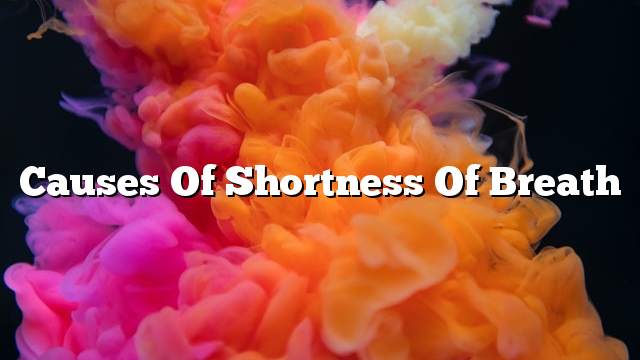hard breathing
In adults with no health problems, the rate of inhalation and exhalation is about 20 times per minute, ie, thirty thousand times a day. Dyspnea is short of breath, unable to catch enough, From the air inside the lungs, a person may feel self-contained, feeling tight in the chest, feeling airless (in English: Air Hunger), and being unable to breathe deeply. Acute Dyspnea may be associated with other symptoms such as coughing, high fever, skin rash, or chronic dryness (Chronic Dyspnea). The person feels unable to breathe during his daily tasks and duties such as moving from room to room or even standing.
Causes of shortness of breath
Shortness of breath is often caused by a health problem in the heart or lungs. They share the transport of oxygen to tissues and the removal of carbon dioxide, so a problem affecting one or both may cause breathing problems. Also lead to shortness of breath.
Causes related to the lungs
Causes of respiratory distress related to lung:
- Asthma (Asthma): It can cause severe or chronic breathing difficulties.
- Pulmonary embolism: Occurs when there is a clot in a pulmonary artery and may cause severe breathing distress.
- Pneumonia: It can lead to severe and temporary breathing.
- Upper respiratory tract obstruction: may cause severe respiratory distress.
- Chronic Obstructive Pulmonary Disease.
- Croup, which occurs in children.
- Lung Cancer.
- Pleurisy: An inflammation of the lining of the chest.
- Pulmonary edema: occurs when excess fluid is collected in the lung.
- Scarring in the lung.
- Pulmonary Hypertension.
- Sarcoidosis: This causes the accumulation of inflammatory cells in the body.
- Tuberculosis (Tuberculosis).
- Interstitial Lung Disease: This disease refers to a group of diseases that affect the interstitium of the lung, a tissue similar to the network of ligaments that extend throughout the lung and support and support the air sacs in the lung, and may lead To chronic obstruction of breathing.
Causes related to the heart
Causes of respiratory distress related to the heart:
- Cardiomyopathy.
- Heart arrhythmia.
- Heart Failure (Heart failure) can cause severe and sudden breathing difficulties.
- Pericarditis, the peritoneum of the heart.
Other reasons
Other causes may cause shortness of breath such as:
- Anemia.
- Broken ribs.
- Epiglottitis.
- Generalized Anxiety Disorder.
- Guillain-Barre Syndrome is an autoimmune and rare immune disorder in which the immune system attacks the nerves of the peripheral nervous system in the human body, leading to weakness, numbness and numbness, and may eventually cause paralysis.
- Inhalation of foreign body.
- Carbon Monoxide Poisoning.
- Diaphragm hernia (Hiatal Hernia).
- Sudden loss of blood.
Diagnosis of breathlessness
Knowing the patient’s history and the clinical examination will provide evidence and indicators to determine the cause and diagnosis of shortness of breath, such as knowledge of the duration of shortness of breath, the factors that increase the incidence of stress, for example, the number of pillows a person uses during sleep and how to sleep. Inventory options for diagnosis.
Diagnostic tests can be performed to assess and diagnose respiratory distress. These tests include the following:
- Electrocardiogram (Electrocardiogram): One of the most effective diagnostic tests.
- Chest radiographs: It is also one of the most effective tests for diagnosis, as it helps to confirm or exclude many possible causes of dyspnea.
- Hemoglobin examination and complete blood count: contribute to determining the severity of anemia as a possible cause.
- Spirometry.
- Arterial Blood Gas (Arterial Blood Gas).
- Full Pulmonary Function Testing.
- Exercise Treadmill.
Treatment of breathlessness
Most patients respond to procedures if the diagnosis is clear and certain. For example, if the cause is diagnosed as a problem in the lungs or airways, the person will be given the appropriate treatment for the problem, such as an enlarged airway medication : Bronchodilators) For the relief of bronchial tubes and respiratory tracts. In the case of anemia, iron supplements are described. Avoid asthma triggers, stop smoking, use oxygen, and participate in pulmonary rehabilitation programs. The Pulmonary Rehabilitation Program contributes to treatment and assistance in some cases. These programs are educational and training programs to raise awareness about lung health and disease, and are aimed at training in exercise and sports with a lower proportion of shortness of breath.
